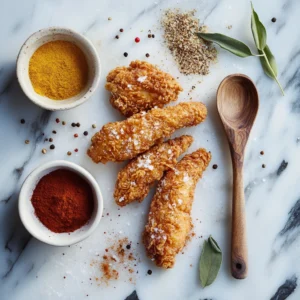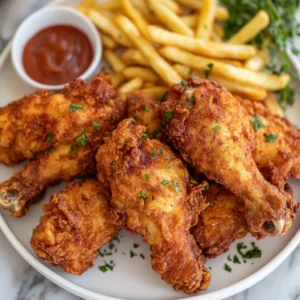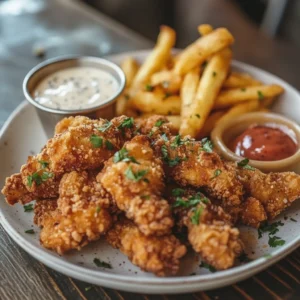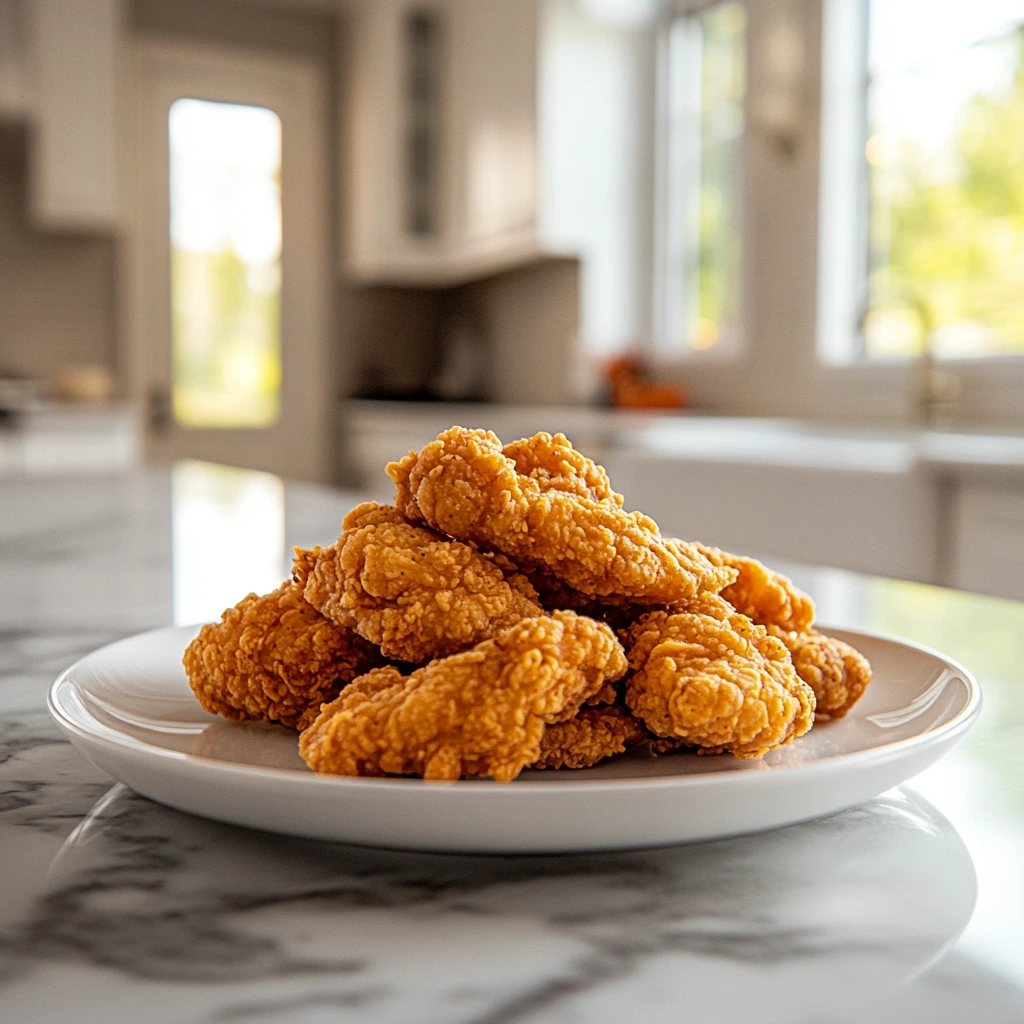Welcome to our definitive guide on creating the perfect fried chicken tenders recipe. In this article, we break down every essential step, from selecting quality ingredients to mastering the frying technique, to ensure that your homemade chicken tenders are irresistibly crispy, juicy, and bursting with flavor.
Whether you are a seasoned cook or a beginner in the kitchen, this comprehensive guide will walk you through the process with detailed explanations, bullet-pointed steps, and expert tips to help you perfect this classic dish.
Additionally, if you’re looking for extra professional advice on preparing fried chicken, visit Crispy Fried Chicken Recipe to complement the insights provided here.
Essential Ingredients and Equipment

Creating the perfect fried chicken tenders recipe starts with high-quality ingredients and the right equipment. Let’s dive into the details to set you up for success.
Ingredients
When selecting your ingredients, aim for freshness and quality. Below is a detailed list of everything you’ll need:
- Chicken:
- Preferably use chicken tenderloins or chicken breasts cut into strips. The quality of your chicken is paramount to achieving the desired tenderness.
- Breading Components:
- All-purpose flour – Provides the base for your coating.
- Eggs – Lightly beaten to help the breading adhere to the chicken.
- Breadcrumbs or panko – These add the crucial crunch factor. Panko breadcrumbs tend to yield a lighter, airier crust.
- Seasonings:
- Salt & pepper – Essential for basic flavor.
- Garlic powder – Offers a subtle depth of flavor.
- Paprika – Adds a warm, smoky note and vibrant color.
- Optional spices: cayenne pepper for a spicy kick or dried herbs like thyme and oregano for added aroma.
- Oils:
- Use oils with high smoke points, such as canola, peanut, or sunflower oil. These oils ensure your chicken tenders fry evenly without burning.
Equipment
Having the right equipment is as important as the ingredients:
- Frying Vessel:
- A deep fryer or a heavy-bottomed pan is essential. A heavy pan helps distribute heat evenly.
- Thermometer:
- Use a reliable thermometer to monitor the oil temperature. Maintaining an optimal temperature of around 350°F (175°C) is key.
- Utensils:
- Tongs are ideal for handling the hot chicken safely.
- A cooling rack or paper towels to drain excess oil once frying is complete.
- Additional Tip:
- For those looking to improve their knife skills for efficient chicken prep, explore our guide on How to Sharpen a Knife: A Comprehensive Guide.
By ensuring that your ingredients and equipment are ready, you are well on your way to creating a dish that will impress both family and friends.
Step-by-Step fried chicken tenders Recipe
Follow these detailed steps to achieve crispy and flavorful chicken tenders every time. Each step is designed to build flavor and texture, ensuring a mouth-watering final product.
Preparation Steps
Proper preparation is the foundation of any great recipe.
- Thawing and Marinating:
- Ensure your chicken is completely thawed if it was frozen. This allows the marinade to penetrate fully.
- Marinate the chicken strips in a mixture of salt, pepper, garlic powder, paprika, and a dash of cayenne pepper. Let it rest for at least 30 minutes. For enhanced flavor, you can marinate for up to 2 hours in the refrigerator.
- Breading Setup:
- Organize your breading station with three distinct bowls:
- One bowl with flour seasoned lightly with salt and pepper.
- A second bowl with beaten eggs.
- A third bowl with breadcrumbs (or panko). Consider adding additional herbs or spices to the breadcrumbs for extra flavor.
- Dip each chicken strip sequentially in the flour, then egg, and finally in the breadcrumbs, ensuring a consistent and even coating on all sides.
- Organize your breading station with three distinct bowls:
Cooking Techniques
There are multiple methods to fry your chicken tenders, each yielding slightly different textures and flavors.
- Deep-Frying:
- Preheat your oil to approximately 350°F (175°C). Gently lower the chicken tenders into the oil, being careful not to overcrowd the vessel.
- Fry until they reach a golden-brown color, usually around 4-6 minutes depending on the thickness of the chicken.
- Pan-Frying:
- If using a skillet, heat a generous amount of oil over medium-high heat.
- Turn the chicken tenders regularly to ensure even cooking and a uniformly crispy exterior.
- Achieving the Perfect Crisp:
- Maintain a consistent oil temperature throughout the frying process. A drop in temperature can result in soggy tenders.
- Avoid frying too many pieces at once; work in small batches for the best results.
- Time and Temperature:
- Use a thermometer to check that the internal temperature of the chicken reaches 165°F (74°C) for safe consumption, while still retaining juiciness.
Post-Cooking Steps
Once the frying is complete, proper post-cooking steps help maintain the texture and flavor.
- Draining and Resting:
- Remove the tenders from the oil using tongs and place them on a cooling rack or paper towels. This allows excess oil to drain, keeping the tenders crispy.
- Allow them to rest for 2-3 minutes before serving.
- Serving Suggestions:
- Garnish with fresh herbs such as parsley or cilantro.
- Serve with a variety of dipping sauces like ranch, honey mustard, or spicy aioli.
Each of these steps is designed to maximize flavor and ensure that every bite of your chicken tenders is perfectly cooked and delicious.
Variations and Customizations of the fried chicken tenders
One of the greatest strengths of the fried chicken tenders recipe is its versatility. Here are some creative ways to customize your dish:
Regional Twists and Flavors

Experimenting with regional flavors can transform a classic recipe into a unique culinary experience.
- Southern-Style:
- Use a buttermilk marinade to tenderize the chicken and add a tangy flavor.
- Incorporate a mix of spices such as smoked paprika and hot sauce into your marinade for that authentic Southern kick.
- Spicy Variation:
- Increase the amount of cayenne pepper or add chili powder into both your marinade and breadcrumb mixture.
- Serve with a spicy dipping sauce or a homemade salsa to elevate the heat.
- Herb-Infused:
- Add dried or fresh herbs such as rosemary, thyme, or oregano to your breading mixture. These herbs add a fragrant aroma and a burst of flavor that pairs well with the savory chicken.
Dietary Alternatives
For those with specific dietary needs or preferences, consider these alternatives:
- Gluten-Free Option:
- Replace regular flour with gluten-free flour blends.
- Use gluten-free breadcrumbs or even crushed gluten-free cereal to maintain the crisp texture.
- Healthier Variants:
- Baking: Preheat your oven to 400°F (200°C) and bake the tenders on a lightly greased baking sheet until they turn golden brown. This method reduces the amount of oil used while still providing a deliciously crunchy exterior.
- Air-Frying: Use an air fryer to achieve a crispy finish with significantly less oil. This method is ideal for those looking to enjoy their favorite dish with fewer calories.
- Explore The Comprehensive Guide to Airfryers Technology for additional insights on healthier frying alternatives.
These variations not only cater to different tastes and dietary requirements but also allow you to experiment and add your own twist to a classic recipe.
Tips, Tricks, and Common Pitfalls
Even experienced cooks can benefit from expert tips. Here are some pointers to help you avoid common mistakes and perfect your fried chicken tenders recipe.
- Maintain Oil Temperature:
- A thermometer is indispensable. If the oil temperature drops too low, your tenders will absorb excess oil and become greasy. Conversely, if the oil is too hot, the breading may burn before the chicken is fully cooked.
- Batch Cooking:
- Fry in small batches. Crowding the pan lowers the oil temperature and can result in uneven cooking.
- Even Breading:
- Ensure that each piece of chicken is uniformly coated in flour, egg, and breadcrumbs. An uneven coating can lead to parts of the tender being undercooked or less crispy.
- Troubleshooting Common Issues:
- Soggy Chicken: Double-check that the oil is at the correct temperature (around 350°F/175°C) before adding more tenders, and avoid overcrowding the frying vessel.
- Overcooking: Use a meat thermometer to monitor internal temperatures, and remove the tenders from the oil as soon as they hit 165°F (74°C).
These expert tips can make a significant difference in the final texture and flavor of your dish, ensuring each piece is consistently perfect.
Nutritional Information and Health Considerations of the fried chicken tenders
While fried chicken tenders are a delightful indulgence, it’s important to be aware of their nutritional profile.
- Caloric Breakdown:
- Depending on the cooking method, a typical serving of chicken tenders may range from 300 to 500 calories. Factors such as the amount of oil absorbed and the size of the chicken pieces contribute to this range.
- Balancing Indulgence with Nutrition:
- To balance the indulgence, consider serving your tenders with a generous side of vegetables or a light salad.
- If you opt for baking or air-frying, you can significantly reduce the calorie content while still enjoying a satisfying crunch.
- Portion Control:
- When serving fried dishes, moderation is key. Enjoy your favorite meal while being mindful of portion sizes and overall nutritional balance.
Understanding the nutritional aspects of your dish can help you make informed choices about serving sizes and accompaniments, ensuring that your meal is both delicious and balanced.
Pairings and Serving Suggestions for the fried chicken tenders

Pair your fried chicken tenders recipe with complementary sides and beverages to create a complete and satisfying meal.
- Side Dishes:
- Classic coleslaw: The crisp, tangy flavors of coleslaw provide a refreshing contrast to the rich, savory chicken.
- Crispy french fries: A classic pairing that enhances the overall indulgence of your meal.
- Fresh garden salad: Light and refreshing, a salad can help balance the heaviness of fried foods. Enhance your salad by checking out The Guide to Tomato Cucumber Salad Recipe.
- Dipping Sauces:
- Ranch dressing: Creamy and cool, perfect for dipping.
- Honey mustard: The sweet and tangy combination is a crowd favorite.
- Spicy mayo or sriracha aioli: For those who enjoy an extra kick of heat.
- Beverage Pairings:
- Iced tea or lemonade: These refreshing drinks are excellent choices to balance the richness of the fried chicken.
- Light beer or crisp white wine: For an adult twist, these beverages complement the flavors without overwhelming the dish.
- For a unique non-alcoholic option, try our Brazilian Lemonade Refreshing Lime Drink Recipe.
By carefully selecting side dishes and beverages, you can transform your meal into a well-rounded dining experience that appeals to all senses.
FAQs
Below are some frequently asked questions to address common queries and help you troubleshoot during your cooking process.
- What is the best oil to fry chicken tenders?
- Use oils with high smoke points, such as canola, peanut, or sunflower oil, to ensure your tenders turn out perfectly crispy without absorbing excess oil.
- How can I make chicken tenders extra crispy?
- Ensure you maintain a consistent oil temperature of around 350°F (175°C) and avoid overcrowding the pan. Double-dipping in the breading process can further enhance the crispiness of your tenders.
- Can I bake chicken tenders instead of frying?
- Yes, baking is a great alternative for a healthier version. Preheat your oven to 400°F (200°C) and bake until golden brown for a less oily yet delicious result.
- How do I keep chicken tenders juicy and tender?
- Marinating the chicken beforehand is essential, as is ensuring you do not overcook them. Use a meat thermometer to confirm that the internal temperature reaches 165°F (74°C) without drying out the meat.
Conclusion and Final Thoughts
In summary, our comprehensive guide has provided you with every detail needed to master the fried chicken tenders recipe. From the careful selection of ingredients and equipment to step-by-step preparation, cooking techniques, and creative variations, each section is designed to help you achieve a dish that is both crispy and flavorful. The inclusion of expert tips, nutritional considerations, and pairing suggestions further enriches your cooking experience.
- Recap:
- Quality Ingredients & Equipment: Start with the best chicken, seasonings, and tools.
- Detailed Preparation: Follow the precise steps for marinating, breading, and frying.
- Cooking Techniques: Choose between deep-frying and pan-frying, ensuring a consistent oil temperature.
- Customization: Experiment with regional flavors, dietary alternatives, and creative twists.
- Expert Tips: Use a thermometer, fry in small batches, and monitor cooking times to avoid common pitfalls.
By investing time and attention in each stage of the process, you can create chicken tenders that not only satisfy your cravings but also elevate your cooking skills to new heights. Whether you’re hosting a family dinner or preparing a quick meal for yourself, this guide ensures that every bite of your fried chicken tenders is deliciously memorable.
For further inspiration and more in-depth recipes, continue exploring our collection. We are dedicated to sharing culinary insights and innovative ideas that transform everyday cooking into an art form.
Bon appétit !

